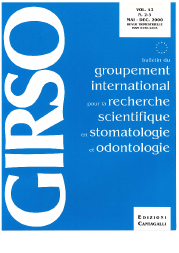KINESIOGRAPHIC INVESTIGATIONS IN CHILDREN WITH INCREASED NASAL AIRWAYS RESISTAN CE
Keywords:
kinesiography, mouth breathing, electromiography, nasal airways resistance, oscillometryAbstract
The aim of this study is to evaluate by means of the kinesiographic test, how the muscular alteration, linked with mouth breathing, modifies mandibular dynamics. From a sample of children aged.between 8-11 years, on the basis of increased nasal airways resistance measured with the forced oscillation technique, we selected a group of 14 subjects. These children underwent kinesiographic examination (K-System Biotronic) and they were compared to a control group. Certainly, the speeds reduction in the pathological group emerged as the most significant data. The mastication tracings on the frontal plane, in the group with increased nasal airways resistance, moreover appeared to be reduced in width, elongated in shape and sometimes irregularly square, compared to the bell shape typical of subjects without any dysfunctional pathologies. Considering that each subject responds in a personal manner to an increase of tbe nasélJ resistances, due to the extremely variable individual adaptability, the kinesiographic test, together with the electrorniographic one, in our opinion, can assist anarnnesis, clínica! examination and other instrumental investigations, in the identification of those subjects in which the increase of the nasal airways resistance interferes with muscular function, laying the basis for possible modifications in the craniofacial growth.Downloads
Published
Issue
Section
License
I hereby certify that the authors of the above manuscript have all:
1. Conceived, planned, and performed the work leading to the report, or interpreted the evidence presented, or both;
2. Written the report or reviewed successive versions and shared in their revisions; and
3. Approved the final version.
Further, I certify that:
1. This work has not been published elsewhere and is not under revision in another journal;
2. Humane procedures have been followed in the treatment of experimental animals (if applicable);
3. Investigations in humans was done in accordance with the ethical standards of the responsible committee on human experimentation or with the Helsinki Declaration (if applicable).
4. This paper has been carefully read by a native English speaker who is familiar with the field of work (this applies to authors who are not fluent in English); and
5. The copyright of the article is transferred from the authors to the Bulletin du Groupement International pour la Recherche Scientifique en Stomatologie et Odontologie upon acceptance of the manuscript.



